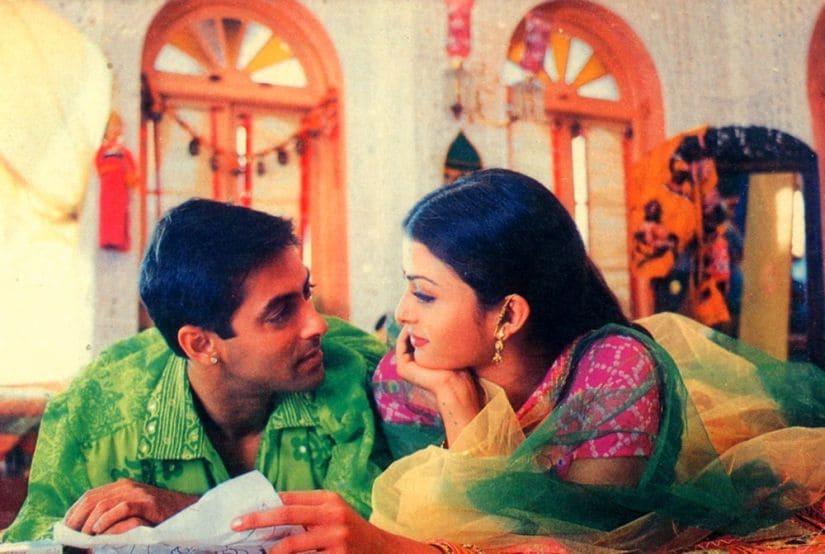Sanjay Leela Bhansali’s films have always been suggestive of a strong, liberating sense of abandon. In the controversial climax of his last film Padmaavat, Deepika Padukone’s Rani Padmini walks into flames, committing jauhar as a mark of rebellion against Alauddin Khilji (Ranveer Singh). In Bhansali’s 2010 drama Guzaarish, Hrithik Roshan’s Ethan Masceranhas and Aishwarya Rai Bachchan’s Sofia D’Souza fight a long battle to earn the right to euthanasia, the ultimate act of letting go of one’s body to avoid further pain. Though the driving force behind the sacrifices in those two films were different — rebellion (Padmaavat) and mercy (Guzaarish) — neither was devoid of enjoying the agency of one’s actions. Bhansali may have glossed over the pain of sacrifice in these two films but also justified his gaze by demonstrating in detail where his characters were coming from. In his 1999 breakthrough Hum Dil De Chuke Sanam (that completes 20 years today on 18 June), however, the atmospherics only amplified the pain of separation or sacrifice that its characters underwent. [caption id=“attachment_6837971” align=“alignnone” width=“825”]  Salman Khan and Aishwarya Rai Bachchan in a still from Hum Dil De Chuke Sanam. YouTube[/caption] The primary driving force behind the idea of letting go in Hum Dil De Chuke Sanam was love. If there is anything about love that Bhansali’s films have portrayed consistently (Saawariya, Goliyon Ki Rasleela: Ram-Leela and Bajirao Mastani), it is that a spoonful of love comes with a gallon of pain. While Ram-Leela and Bajirao Mastani are accounts of star-crossed lovers who die in each other’s arms or on the verge of separation, the poetic notion of meeting the same end together was not associated with Hum Dil De Chuke Sanam. It went the Saawariya way (though so much better) as every principal character had to watch their loved one walk away. Bhansali’s depiction of the classic notion, ’love means letting go’, is spread across three parts in the film. It follows the three-act format of a conventional feature film. The first act of letting go is performed by Salman Khan’s character Sameer. However, the reason behind his first sacrifice is not love, but commitment. After he falls in love with Aishwarya’s character Nandini, her father demands he walk away as part of his gurudarkshina (token to a teacher) for teaching him music. He honours his commitment and travels across a barren desert, away from a distraught Nandini, as KK’s evocative ‘Tadap Tadap Ke’ plays in the background.
The second act of letting go is performed by Ajay Devgn’s character Vanraj, who marries Nandini after Sameer leaves the town. Nandini gives into her father’s wish of an arranged marriage but is pleasantly surprised by Vanraj’s response to her halfhearted approach to their relationship. Completely aware that he cannot win over Nandini, Vanraj offers to help Nandini trace Sameer. Through his efforts to find Sameer in Italy, Vanraj tops even the ultimate act of letting go, as he commits to reunite his wife with her ex-boyfriend. As the title track serenades the background, he often visualises multiple instances of Nandini walking away to Sameer.
The third and final act of letting go is performed by Nandini when she finds herself in the classic dilemma of choosing the one who loves her as opposed to the one she loves. On one hand, there is Sameer whom she has been chasing for years, and on the other hand, there is Vanraj, who has stood beside her like a rock through the entire process. On one side is a man who left her to honour a commitment, and on the other hand is a man who is willing to let go of his commitment to her for the sake of keeping her happy. “Pyaar karna tumse seekha, pyaar nibhana unse,” Nandini tells Sameer in the electric climactic scene, before walking away to Vanraj.
That moment marks the confluence of commitment and love for Nandini, who realises she has started loving the man she is ‘committed’ to. Just like Vanraj, she gives precedence to love over commitment. Sameer lets go of her again, but this time it is out of neither commitment nor love. His sacrifice stems from helplessness as he claims he cannot see the love that he used to in Nandini’s eyes. As Vanraj and Nandini unite, Sameer sulks in a church cursing his late father for stealing Nandini from him. Through Sameer’s conversation with his dead father, Bhansali reiterates that Salman’s character has the tendency to hold on — to the death of his father, and to the assumption that his childhood love will continue forever. His parting with Nandini is painful only because he does not let her go. On the other hand, Nandini allows her love some breathing space and is courageous enough to let it decide its own course.


)
)
)
)
)
)
)
)
)



